PHOTOS: Exploring 3rd-Century Diocletian Aqueduct
May 10, 2020 - The Diocletian Aqueduct is an archeological site in Solin, a suburb just outside the city of Split.
Dalmacija Danas reports that this Roman aqueduct was built at the same time as Diocletian's Palace (late 3rd - early 4th century), its purpose was to bring larger amounts of drinking water from the source of the Jadro river to Diocletian's Palace, and most likely the surrounding settlements.
From the source of the Jadro river to the Palace, the aqueduct is about nine kilometers long, and visitors can explore its underground part, which is about 700 meters long and starts at the 5th kilometer.
Polish blog Crolove explored the site two years ago, and wrote that the difference in level is 33 meters and the slope is equal 3% on the entire stretch. You can find steel pins nailed into the wall of the tunnel every few tens of meters, which were used to fit a string that helped the constructors set the slope.
The Diocletian Aqueduct stopped working as early as the middle of the 6th century when it was damaged in the invasion of the Goths, after which it did not work for a full 13 centuries. It was mostly renovated during the reign of the Austro-Hungarian Empire and there is evidence that the renovation was done in earlier periods as well.
Since 1932, when the modern water station in Kopilica began working, this famous Roman aqueduct was abandoned, as new pipes for water supply to the city of Split were laid, and only the excess water flowed through the old aqueduct.
In 1948, after the typhus epidemic, the use of drinking water from aqueducts was prohibited. Since 1979, the aqueduct was completely interrupted (downstream from the intersection of today's Domovinskog rata and Puta Stinica streets).
The aqueduct is currently being restored.
Sapa Split, a local photography group, accompanied The Mladichi on an exploration of the ancient aqueduct a few days ago. You can check out their experience below.
To read more about lifestyle in Croatia, follow TCN's dedicated page.
Changing of the Guards in Full Swing: Actor Maro Nejašmić Banić Plays Diocletian
The Split Tourist Board and the Croatian National Theater have organized the changing of Diocletian’s guards on Peristyle during the tourist season for years.
Another Historical Treasure Unveiled in Heart of Diocletian's Palace!
The interior of Diocletian’s Palace unveils a new historical treasure.
VIDEO: 3D Animation of Diocletian's Palace
Diocletian’s Palace, the staple of Split and the pride and joy of Splićani, is rich and full of history - but how much do you really know? We guarantee you that this 3D video will grant you new knowledge and wisdom about your favorite Roman emperor, and you’ll even be entertained watching it.
New Archaeological Discovery Proves Greeks Were in Split Long Before Diocletian
Unfortunately, even though this new archaeological site is of great significance, it will be recorded and covered since it is in a location of a future bus and taxi stand.
Sites in Split: The Cellars of Diocletian's Palace
The cellars of Diocletian’s Palace are housed within the southern half of the palace. The floor plan showcases a mirror image of the emperor’s residence above as this substructure acted as supporting walls. The basement halls was the entranceway into the palace by sea via the Brass Gate and previously, when the sea reached the very walls of the palace, boats would be able to berth in front of the gate to drop off supplies or receive noble guests. As you pass through the basement towards the north you will reach the stairs that lead you directly up the Peristil Square.
During the time of the emperor, the basement was largely used for storage of foodstuff and wine. Actually, the remnant of a large press, which was used to turn the grapes into wine, is still visible today showcasing that Diocletian surely enjoyed a glass or two of his own Dalmatian wines down here.
As you meander through the underground, find the circular room and notice the impeccable acoustics; above, this room was the foyer to the emperor’s bedrooms and Diocletian would be warned if anyone was coming at night due to the echoes left by anyone passing through. Emperor Diocletian was very paranoid about being killed and had specifically requested this feature; apparently with success as he is the only Roman emperor to have died of natural causes.
After the fall of the Roman Empire and the consequent settlement of various civilizations, the basement was used for various purposes. In the Middle Ages it was inhabited, and eventually it turned into a water storage facility but through time, the basement got clogged up completely. As additional houses were built above the basement, they drilled holes into their floors in order to use the basement is a sewage tank and garbage dump.
Croatian architect and the country’s first conservator, Vicko Andrić who constructed the Riva harbor-front devoted his retirement to the conservation of Diocletian’s Palace and began an excavation of the cellars in the 1850’s. Andrić drained and cleaned the cellars and archeological discoveries are still being made to this day, particularly in the far corners of the basement. Amongst other finds, older remains from the previous civilization of Aspalatos were also found.
Today, the cellars are open to the public although the eastern part was only opened up in May 1995 after the celebration of the patron saint of Split, Sv. Dujan (St. Domnium). The main hall of the basement houses tacky souvenir stalls where tourists can buy a reminder of their stay in Split. The other areas of the basement reveal a labyrinthine room layout, ideal for an archeological discovery. The basement is also a popular venue for various events such as art exhibitions, weddings, and the International Flower Show held in May.
Sites in Split: Diocletian’s Palace Gates
The nucleus of Split is most definitely Diocletian’s Palace, a 1700-year-old Roman structure measuring approximately 160m by 190m. A gate or entranceway is located in the center along each of the four walls that lead down to the central square of Peristil, dividing the palace into four quarters.
Golden Gate
This gate was originally called Porta septemtrionalis but was renamed into Porta aurea (Golden Gate) by Venetians, which is what it is known as today.It is located on the northern wall of the palace adjacent to the Strossmayerov Park (Đardin) and the statue of Grgur Ninski. It is connected to a cardo, a north-south main street, leading to the central square of Peristil; this street is known as Dioklecijanova today (Diocletian’s Street).
The Golden Gate is the main entrance to the palace and was used by the emperor when he entered his new home for the first time on June 1st, 305 AD as he arrived from his nearby town of Salona (Solin). Its grand façade is decorated with niches where sculptures of four regional rulers once sat. The four rulers included Diocletian himself, his co-emperor and subordinate Maksimian, emperor and later son-in-law Galerius, as well as emperor and governor of Dalmatia Constantine Chlorus. Previously, there were octagonal towers on either side of the gate and later a large Benedictine convent, which was later commissioned as a military hospital. None of these structures exist today however, remains of the Benedictine convent can be seen nearby at the Chapel of Arnir featuring an altar slab and sarcophagus made by the early Renaissance sculptor and architect Juraj Dalmatinac.
The Golden Gate had double gates creating a Propugnaculum, a defense system or human trap where invaders would be captured between the outer and inner gates into an enclosure or courtyard measuring 9m by 9m. The inner gate was made of solid wood and the outer gate consisted of metal bars, which were lowered when invaders entered the enclosure.
Sitting above the gate is the 5th century Chapel of St. Martin, the patron saint of soldiers. This miniscule chapel measuring just 5 meters in width is one of the earliest Christian chapels anywhere and was built for the troops who guarded the gate. If you are lucky, you can access the chapel by a narrow stairway by turning right after passing through the gates and ring the doorbell of the Dominican convent. The nuns here look after the chapel and are happy to showcase its charming beauty and impressive history to visitors.
As you look upon the gate from the outer walls today, you can see that life still breathes in the palace and within the ancient walls themselves; notice the arches have been bricked and fitted with windows, laundry is drying, and a resident’s private terrace sits above the inner gate.
Brass Gate
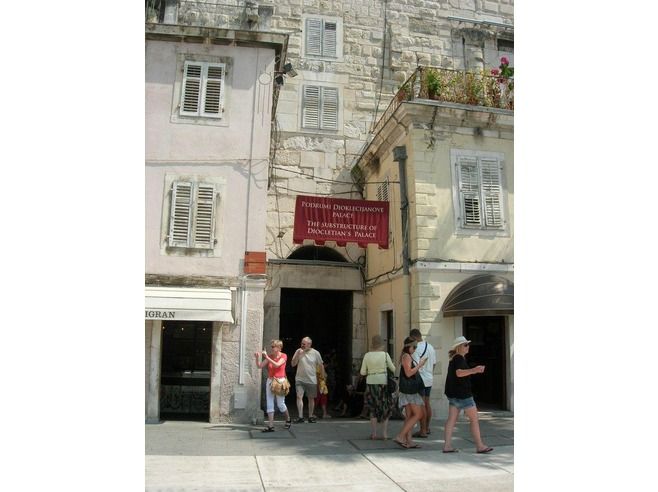
Image by members.virtualtourist.com
This gate was originally called Porta meridionalis but was renamed into Porta aenue (Brass Gate) by Venetians, which is what it is known as today. It is located on the southern wall of the palace, adjacent to the sea and popular Riva harbor-front promenade. It connects into the basement halls of the palace leading below the emperor’s imperial quarters up the stairs to the Peristil Square, and further down the cardo to the Golden Gate.
The Brass Gate is much smaller and simpler than the other gates and originally, there was no Riva and the sea reached the very walls of the palace. The Brass Gate was the entrance by sea into the palace. The gate was also dubbed the “safety gate” because it enabled the emperor and others to escape by sea in case of danger. It also acted as a service entrance for supplies that came by boat.
Today, the Brass Gate is the most popular passageway for tourists as it leads you to all the souvenir shops located in the basement halls. The basement halls showcase the substructure of Diocletian’s Palace consisting of many rooms and wall work as supporting walls for the emperor’s residents above. As you meander through the underground, find the circular room and notice the impeccable acoustics; above, this room was the foyer to the emperor’s bedrooms and Diocletian would be warned if anyone was coming at night due to the echoes left by anyone passing through. After the time of Diocletian, the basement was filled up with dirt and sewage but was excavated in the 1850's where they also discovered even older remains from the previous civilization of Aspalatos.
Silver Gate

Image by www.visitsplit.com
This gate was originally called Porta orientalis but was renamed into Porta argentea (Silver Gate) by Venetians, which is what it is known as today. It is located on the eastern wall of the palace, adjacent to main green market, Pazar and the church of St. Dominic. It connects to the decumanus, an east-west main street leading to the central square of Peristil and on to the Iron Gate, exiting onto the Pjaca Square.
Although less apparent today, the Silver Gate also had a Propugnaculum, a defense system or human trap where invaders would be captured between the outer and inner gates. The Silver Gate however, is not as richly decorated as the Golden Gate but you can vaguely spot the remains of the octagonal towers on either side of the gate.
Like three of the gates in the palace, the look-out corridor above the gate was transformed into a church in the 6th century dedicated to the gate’s patron Saint Apollinaire who, during the Early Christian period was a saint worshipped all over the Mediterranean. It was believed that the saint’s supernatural powers protected the city from invasions from the East.
The gate was bricked up during the Middle Ages for security reasons and later other structures covered the out walls and later a smaller opening directly next to the gate called the Venetian Gate was created to gain access to the palace. During World War II, the gate was heavily damaged and the Baroque church “Dušica” which was also incorporated within the gate walls was also destroyed. In the 1950’s, the gate underwent a thorough renovation and re-opened.
Directly outside the gate is the Church of St. Dominic, first mentioned in the 13th century but got its current structured in the 17th century and later it underwent an expansion in the 19th century. Within the church you will find a fascinating painting from the Middle Ages titled “Miracle in Suriano” by Palma il Giovane, a gothic crucifix, preserved wooden Baroque altars, an ancient organ, and the tomb of Arrigoni, the early 17th century bishop of Šibenik.
The most recent highlight of the Silver Gate was when Pope John Paul II paid a visit to Split in 2000; he passed through the gate in his “Popemobile” and driving along the wide decumanus, much like the emperor did in his chariot almost two millennia ago.
Iron Gate
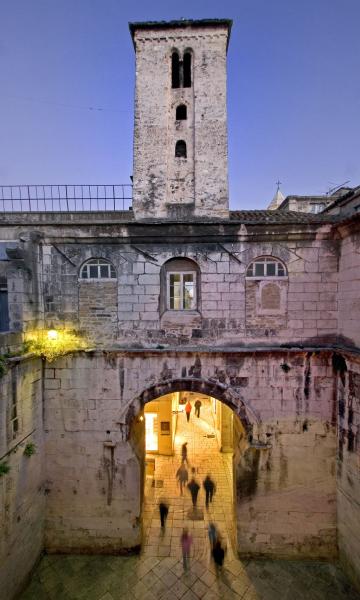
Image by www.visitsplit.com
This gate was originally called Porta occidentalis but was renamed into Porta ferrea (Iron Gate) by Venetians, which is what it is known as today. It is located on the western wall of the palace, at the exit to the popular Pjaca Square. It connects to the decumanus, an east-west main street leading to the central square of Peristil and on to the Silver Gate.
The Iron Gate is the most cluttered of the four gates as centuries of developments have been built around and Romans, Avars, Slavs, Italians and French have all left their mark here.
Clearly visible, the Iron Gate also had a Propugnaculum, a defense system or human trap where invaders would be captured between the outer and inner gates. This gate was the only free port of entry during the Middle Ages and therefore, the enclosure between the outer and inner gate served as a courtroom where the fate of those seeking refuge in the palace would be decided.
The early Christian Saint Teodor was the protector of the Iron Gate and in the 6th century a tower-like church was erected above the gate on the sentry corridor to honor him. Built in Romanesque style, its design is rather modest. The structure has two floors but you will notice three rows of windows; this was to provide an illusion of three floors.
An expansion of the church was made one millennium ago and with another tower, “Gospa Zvonik” or our Lady of the Bell Tower. It is an early-Romanesque tower topped with a gothic bell-tower. It has a little double arched window and a grand clock on its façade. The clock is captivating as it is divided into 24 parts instead of 12.
Guardians of Gods and Emperors: All the Sphynxes of Split
Split was founded thanks to a Roman emperor Diocletian, and most of its heritage can be traced all the way to Roman times. However, probably one of top five the most photographed spots in Split has even older origins, ancient Egyptian. Of course, we are talking about Split Sphynxes. The one in front of the cathedral is the best preserved, and definitely the most famous, but there were much more of them scattered around the Palace by Diocletian. What they were doing there, how many of them once existed, and where are they now?
A whole series of Sphynxes were brought to Diocletian's Palace while it was still under construction, and my friend, one of the leading Split tour guides Leo Nikolić believes it was because Diocletian considered himself as a God's given, or son of Jupiter. It was very close to Egyptian pharaohs concept of ruler and God in one person. There was also a practical reason - Egypt was Diocletian's private property, as it was the case with all Roman emperors, and he could have brought anything he wanted from there, at almost no cost. Some things never change. Whatever the reason was, those divinal statues are probably the oldest objects in Split, about 3,000 years old.
As far as we know now, there were at least eleven Sphynxes around the Palace, judging from those who remained, or by the fragments found. After Palace was christianized, like the whole empire, pagan symbols were crushed symbolicaly, but even literally. After all, Diocletian was an arch-enemy for Christians, having them killed by thousands. It was quite expected that every memory on him will be destroyed.
Split Sphynxes always drew travellers' attention, I recently found beautiful photo made by Franz Thiard de Laforest in 1870s. Much before that, Robert Adam drew it as part of his studies of the Palace.
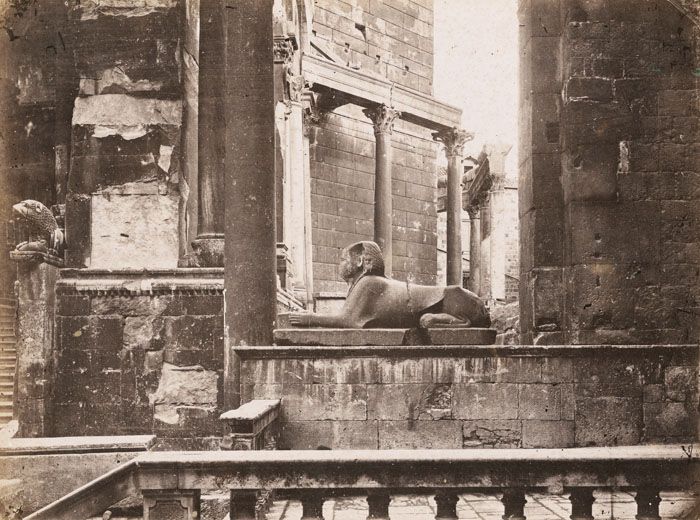
The best preserved Split Sphynx is the one in front of the cathedral, although even this one was cut in half. Still, it's visible in its full beauty, even with hyerogliphs inscription at the bottom. It was probably one of two, or maybe even four keepers of Diocletian's Mausoleum. It was probably brought from some ancient temple in Karnak.
Second one is the one that probably stood opposite from the previous one, and is now in the Archeology Museum after being donated in 1875. by one of Split noble families. This one is a little bit smaller, and made probably around 1,400 BC, maybe for one of temples in Thebe.
Same museum holds several other fragments. For example, back part of the one made of white stone, or head made of red granite found in Salona.
During excavations around Vestibule small black granite Sphynx was found beheaded This one is now in one of the halls of Palace's substructures. There we can also see the small fragment of front legs and chest made of red granite.
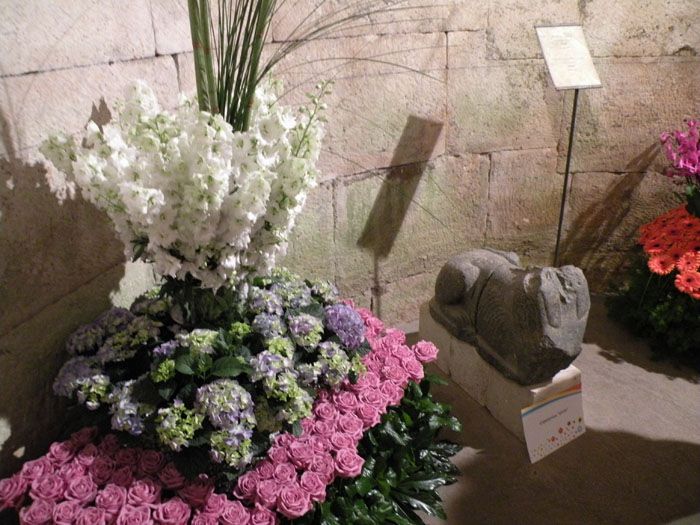
There are some fragments that can be found as part of facades of buildings around the Palace. The most famous is the red granite head near the green part of the Palace, popular "Vrtal", or Garden. However, there is a theory that it was part of some other Egyptian statue.
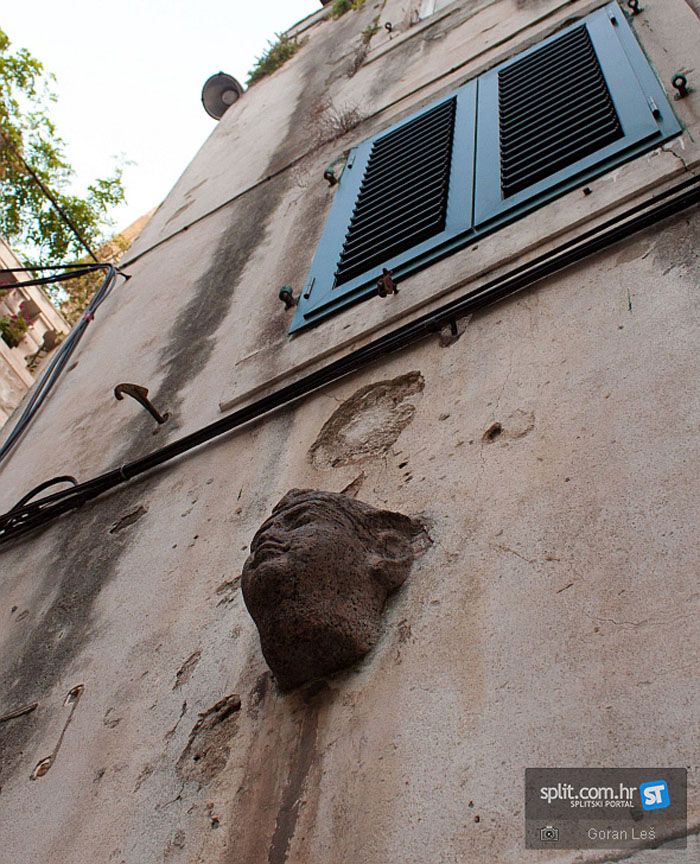
Very well preserved, although without head, is the one in front of the Jupiter's Temple, or baptistry. This one was also found during excavations in the nearby area, and brought to present position for decorative reasons. Split City Museum keeps the one made of grey and black granite, another one without the frontal part. Same museum keeps Sphynx head made of red granite, found during excavations of ancient draining system. There are also some other smaller fragments, like feet, chests, or legs, but it's hard to expect that any other better kept Sphynx will ever be found.
Split Looking for the Location for the Statue of Emperor Diocletian
Where will be the final resting place for Split's Roman Emperor?



